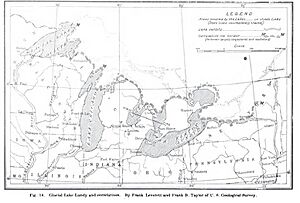Lake Duluth facts for kids
Quick facts for kids Lake Duluth |
|
|---|---|

Glacial Lake Duluth
|
|
| Lua error in Module:Location_map at line 420: attempt to index field 'wikibase' (a nil value). | |
| Location | North America |
| Group | Great Lakes |
| Lake type | former lake |
| Etymology | Sieur Duluth |
| Primary inflows | Laurentide Ice Sheet |
| Primary outflows | St. Croix River |
| Basin countries | Canada United States |
| First flooded | 11,000 years before present |
| Max. length | 152 mi (245 km) |
| Max. width | 73 mi (117 km) |
| Surface elevation | 1,300 ft (396 m) |
Lake Duluth was a huge, temporary lake that formed about 11,000 years ago. It appeared in the area where Lake Superior is now. This happened as a giant ice sheet, called the Laurentide Ice Sheet, slowly melted and pulled back.
Lake Duluth was a "proglacial lake." This means it formed right at the edge of a melting glacier. It was located at the western end of the Lake Superior area. The water from Lake Duluth flowed south through rivers in Minnesota and Wisconsin. Its surface was about 331 meters (1,086 feet) above sea level.
Contents
How Lake Duluth Formed
As the Superior part of the Laurentide Ice Sheet melted, water got trapped. This created several smaller, separate lakes. These lakes are named after the modern river basins where they once stood.
Smaller Lakes Before Duluth
- Lake Nemadji was in the area of the Nemadji River.
- Lake Brule was in part of the Brule River basin.
- Lake Ontonagon was in the Ontonagon River basin.
These smaller lakes were all west of the Keweenaw Peninsula. East of the peninsula, the melting ice water flowed into Green Bay or Lake Michigan. This happened through channels crossing the western part of Michigan's Upper Peninsula.
Lake Duluth eventually stretched a bit farther east than the Keweenaw Peninsula. It reached the edge of the Huron Mountains. In the early days of the ice melting, Lake Duluth used the St. Croix River Valley as its main outflow.
Later, as the ice continued to melt, the smaller lakes joined Lake Duluth. Or, their water levels dropped as they merged with Lake Duluth.
Other Early Lakes
- Lake St. Louis existed when the Superior ice lobe was at its largest. It was in the St. Louis River area.
- Lake Nemadji had an outlet channel that went west. It joined the outflow of Lake St. Louis near Moose Lake.
- Lake Brule was a small lake south of the copper range. It also flowed into the St. Croix Valley. This was before Lake Duluth used the St. Croix as its main outlet.
- Lake Ashland covered parts of northwestern Ashland County, Wisconsin. It also reached into Bayfield County.
- Lake Ontonagon filled much of the Ontonagon basin. The ice border stayed along the copper range for a long time while this lake existed.
How Lake Duluth Grew and Changed
As the ice lobe moved north, these smaller lakes joined together. They formed one large lake at the level of the St. Croix Valley outlet. Lakes Nemadji, Ashland, and Ontonagon likely merged with Lake Brule at lower water levels.
Lake Nemadji and Lake Ashland dropped less than 20 feet (6 meters). Lake Ontonagon dropped almost 200 feet (61 meters). Its former area is now dry land. Lake Duluth also had several narrow bays that reached up into the tributaries of the Ontonagon River.
The ice lobe continued to melt and move eastward in the Lake Superior basin. This process took a very long time. As the ice retreated, the outlet channels became deeper. This caused the beaches around Lake Duluth to drop to lower levels. So, the higher beaches in the eastern part of the basin are actually extensions of the middle and lower beaches in the western part.
Eastern and Northern Edges
The eastern edge of Lake Duluth on the south shore was near the Huron Mountains in Marquette County, Michigan. Once the ice moved east of these mountains, new paths opened up. These paths allowed the meltwater to flow into the Lake Michigan basin. This caused Lake Duluth's water level to drop.
Eventually, the water level reached that of Lake Algonquin. This huge body of water covered the western part of the Lake Superior basin. It also covered the basins of Lake Michigan and Lake Huron, and later the eastern part of the Lake Superior basin.
The northern edge of Lake Duluth, on the Canadian side, is not fully known. However, we know it reached at least to the Kaministiquia River basin. This is west of Fort William, Ontario. It's likely that the ice pushed into Keweenaw Bay. This might have kept the east end of the Keweenaw Peninsula under ice until Lake Duluth's waters drained eastward.



